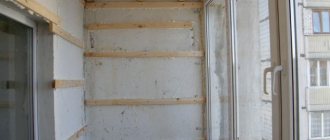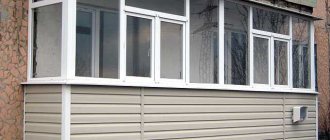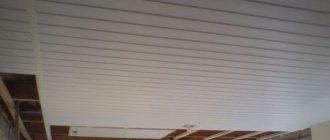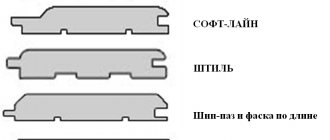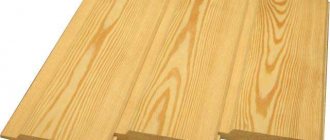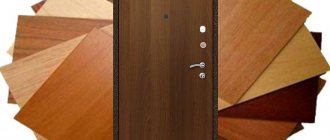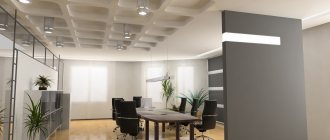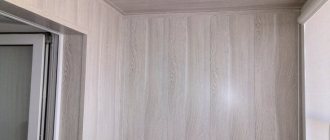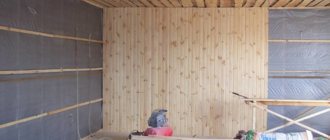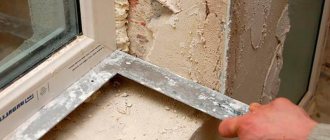What to hammer in: nails, screws or staples?
The lining itself is a board with a certain profile, which must have a tongue-and-groove locking connection. It is attached to the wall or ceiling using nails, screws or staples. The tools and material required to hammer in the lining in the bathhouse are as follows:
- nails, screws, staples;
- hammer, screwdriver, hardware gun;
- a mallet or a piece of clapboard for knocking a tenon into a groove;
- building level.
What nails should I take for the lining in the bathhouse? It is desirable that these are finishing nails 30-40 mm long, with an anti-corrosion coating . It’s worth taking coated screws (their length is the same, by the way). Regarding the length, you should proceed from the thickness of the board (if in a groove, then only the walls of the groove), plus you need to punch through the block to which the board is attached at least to the middle.
The staples should be the same size, although there are comrades who nail 14-mm staples with a construction stapler through a clamp, but this is rather an exception. To properly line a bathhouse with clapboard, it is better to use long staples and shoot them at an angle of 45 degrees (approximately).
Of course, it is tempting to wonder which of these methods is better . There cannot be a definite answer to this, because everything depends on the experience of a particular person. And if it is not there, then the easiest thing to do is to shoot the staples using a pneumatic gun.
True, it is not cheap, and few people would agree to buy it for a one-time job. Other methods are a little more difficult to implement.
Method number 1 - how to sheathe walls with horizontal clapboard
Remember, work starts from the top - from the ceiling down to the floor.
The groove of each plank is better if it is directed downwards. This additionally protects the walls from debris or moisture penetration. You can fasten the lining to the sheathing with clamps (tin fastening grips), staples and decorative screws, or simple upholstery nails. The clamp is fixed in the recess of each panel, without interfering with the next one being installed in the groove. It is advisable to check the level and correct installation more often. As a decorative option, craftsmen use rounded logs, or rather, their imitation. Such a log lining is called a block house. In this case, the panels are attached to the sheathing with the grooves up, screwed with self-tapping screws. Each subsequent fastener is hidden from view by the previous board.
Do-it-yourself finishing of a bathhouse with clapboard inside - step-by-step instructions
The choice of facing materials is significant. But if we are talking about such a specific “object” as a bathhouse, then upon closer examination there are not so many options. And this mainly concerns only the types of panels, since both experts and land owners agree that the best solution for finishing is wooden lining. Let's consider all the nuances of finishing the inside of a bathhouse with clapboard.
The concept of do-it-yourself always means a simple tool (household level), accessible technology and inexpensive materials. This is where the author proceeds. Let's start with the preparation stage for finishing the bath.
Little things you need to know
Craftsmen, as a rule, tend to choose lining that is made of pine. Wood panels are made from a huge selection of different species, but pine is favored by its aesthetic and technological characteristics; this species is most suitable for those who are just starting to try themselves as a decorator.
Particular attention should be paid to the material from which the walls are made. The method of fastening the panels directly depends on what your walls are made of.
An important issue is the load-bearing qualities of the walls. If the building is dilapidated, then covering the room with wooden lining is unacceptable, due to the heavier structure than that of plastic lining (the latter is much lighter than wooden).
Clamps for profile installation are selected taking into account two factors: operational and technical features of the material and walls. Staples or small nails will do an excellent job of installing planks.
What clapboard to cover the inside of the bathhouse
The lining for finishing the steam room is selected according to the following characteristics:
- type of lumber - when finishing a paired room with boards from a certain type of wood, eurolining is more often used;
- grade - the steam room is sheathed only with boards made from various elite types of wood, which do not contain knots or wormholes.
However, sometimes even living wooden knots fall out over time due to temperature fluctuations.
Types of wood for making bath trim
In order to choose the right specific lining for a steam room, you first need to familiarize yourself with the characteristics of the wood species from which the board is made. The lining of the steam room with such lumber is made from deciduous or coniferous trees.
Most often, bathhouse finishing is performed with the following species:
- Linden. It is highly resistant to moisture, retains the original color and structure of the board. In addition to finishing the bath, linden is used in the manufacture of a bath shelf, bench, ladle or door.
- Aspen. A soft breed that is highly resistant to water and steam. After intensive drying, the aspen becomes denser and stronger.
- Cedar. The most expensive of finishing materials. Cedar heats up less than linden and aspen, and also does not form resin like pine, so it does not burn the skin.
- Pine. An inexpensive tree that is rarely used in steam rooms. Much more often, a small dressing room or a separate room for relaxation is sheathed with pine.
The ceiling of the steam room is not covered with pine clapboard. After all, after heating, the released resin begins to drip onto the floor.
Standard lining parameters
The size of wooden clapboards is directly related to the type of wood from which they are made. Below are the recommended lumber specifications: width, length and thickness.
Such information is needed to correctly select the optimal number of lining boards. There are several differences between varieties.
| Breed | Dimensions | ||
| Width, mm | Length, m | Thickness, mm | |
| Aspen | 76-200 | 0,2-6 | 12-40 |
| Oak | 50-108 | 1-3 | 12,5-15,0 |
| Pine | 50-108 | 0,5-3 | 12,5-15,0 |
| Larch | 76-200 | 0,2-6 | 12-40 |
Wooden eurolining has the following standard dimensions:
- width – 80-120 mm;
- length – 0.5-6 m;
- thickness – 13-19 mm;
- spike size – 8-9 mm.
A simple lining has the following parameters:
- width – 8-15 cm;
- length – 0.6-6 m;
- thickness – 1.2-2.5 cm.
EU standard lumber has the following parameters:
- width – 96 mm (maximum);
- length – 2.1-3 m;
- thickness – 12.5 mm.
Russian enterprises produce the following sizes:
- width – 8-12 cm;
- length – up to 6 m;
- thickness – 1.3-1.9 cm.
More often, when lining baths, the following profiles are used:
- width – 96 mm;
- length – 2-6 m;
- thickness – 12.5 mm.
Thus, most of all, similar boards are distinguished by length. Their direct purpose is associated with this parameter.
Types of lining by profile
There are 4 types of linings, which are distinguished by the profile of the boards:
- standard;
- eurolining;
- block house (log imitation);
- American.
When finishing a bathhouse, the following grades of lumber are used:
- "Soft Line";
- "Calm";
- "Classical".
All these boards are eurolining and have a variety of sizes and profiles. They are sometimes called lamellas.
What kind of clapboard to cover the steam room of a bathhouse
When covering a steam room with wooden clapboards, the following lumber is most often used:
- linden board tolerates changes in air temperature, exposure to hot water and the formation of steam well, so lumber from it does not deform or discolor;
- aspen lining, in terms of parameters it is no worse than linden boards, and also has a lower cost;
- boards made of maple and alder; lumber made from such wood has low thermal conductivity, so they are often sheathed in any bathhouse, including a steam room.
Advice! When buying lining for a bathhouse, you must take into account the fact that in such a room the air temperature sometimes reaches 100 degrees. Therefore, to decorate such a room, it is better to buy lumber only from “safe wood”.
Pros and cons of cladding
During production, this type of finishing undergoes careful processing, including natural and chamber drying, grinding of the front surface, and in the case of eurolining, coating with antiseptics and fire retardants.
The result is a high-quality, durable edged groove board, which is easy to install and looks great in any interior. Advantages of lining:
- Aesthetics – depending on the type of wood, the front surface has a unique grain pattern.
- Environmental friendliness - wood, when processed with high quality and coated with only harmless protective compounds, is an absolutely safe finish for humans.
- High hygroscopicity - due to the structure of the material in the room, the microclimate and humidity level are effectively regulated, which make staying in it comfortable.
- The smell of natural wood is often almost undetectable, but it helps cleanse the air of extraneous aromas, refreshes the air, and fills it with a special atmosphere.
- Simple installation - attaching slats is simple and quick (how to attach lining?). The process often takes several days, taking into account the treatment of the lining and supporting structure with protective compounds, the preparation and painting of panels, acclimatization of the material and fastening.
- Long-term operation - when all processes are carried out using the recommended technologies, such cladding retains its appearance for up to ten years with minor corrections of the coating every couple of years.
- Reliable sound and heat insulation - allows you to create cozy rooms protected from extraneous noise and heat loss (how to insulate a room with clapboard, how to install thermal insulation is described in detail here).
- High strength of the cladding – resistance to mechanical damage and loads.
Advice The most important advantage is its natural origin, because there is no better material than one created by nature itself.
The lining has a number of disadvantages:
- low moisture resistance - wood without a protective layer absorbs moisture well, which over time deforms the canvas;
- low heat resistance - even minor temperature changes can cause bending or twisting of the lamellas;
- low fire resistance - if the material is not coated with fire retardants, then the risk of fire is very high, since wood is a highly flammable lumber.
But all the shortcomings can be easily eliminated with various impregnations, varnishes, paints, oils, and other protective compounds, making the cladding more durable, reliable, and durable (how to varnish or paint lining?).
Video editing
For a better understanding of the process, you can also watch this video of lining installation and preparatory activities, with nuances.
https://youtube.com/watch?v=Qd5q2wRbFQM
More on the topic
How to lay floors in a steam room?
All the advantages of a barrel sauna, design
Which foundation to choose for a bathhouse or house, and how to make it yourself
Article posted 3 years ago by Vadim Glukhovchenko
“I live in the city of Shatura, Moscow region. Since childhood, he was “turned” to construction. Mastered many professions, incl. carpenter-concrete worker, mason-builder, furniture maker. I share my experience on this blog.”
How to lay: horizontally or vertically?
Unfortunately, when choosing a method for cladding the inside of a bathhouse, we cannot be guided only by aesthetics. More precisely, not so: aesthetics can be the basis of choice only in a dry room , for example, in a rest room or dressing room.
If you decide to use it to decorate wet rooms (steam rooms and washing rooms), then it is better to focus on a method that minimizes future losses . By “losses” we mean possible damage to the planks from moisture, which will require their replacement.
So, what happens when the installation of lining in a bathhouse is carried out vertically? In a humid room, humidity is distributed unevenly - after all, gravity drives it towards the floor. As a result, each (!) plank also gets wet unevenly.
When it dries, this can lead to cracking, but more often, over a long period of time, problems accumulate at the bottom - somewhere there is not very good ventilation, for example, and in this place the water stagnates. Therefore, the planks begin to rot. And since we have them located vertically, the rotting area affects all the planks.
This is what’s inconvenient - in order to dismantle and replace damaged areas, you will have to cut (not replace the whole thing!), and then replace each piece. The cost of time and effort is especially clearly visible if we compare the situation with the horizontal upholstery of a bathhouse with clapboard - in this case , several strips are replaced entirely, which does not cause any special problems in dismantling and installation.
The only disadvantage of horizontal cladding of a bathhouse from the inside with clapboard can be considered a visual reduction in the height of the sheathed room, and in the bathhouse, as you know, the ceilings are already low. Therefore, as an option, you can combine both methods using the horizontal one at the bottom.
Methods of finishing a room
Of the many examples of design work, we will analyze the most popular. If clapboard finishing is carried out inside a country house, detailed photos of ideas on how to design the room can become the main assistants in the implementation of the interior of the room.
- The first method lies in the contrast of colored walls and a darker ceiling. Suitable for apartments with high ceilings. Visually expands the room.
- The second method: colored walls and a light ceiling - on the contrary, it will narrow the space. It is advisable to paint the walls in bright colors.
- The third method of painting - one color, but in two tones - will give the room a finished look. Lining for finishing this style will round out the room. However, the boundaries of the color transition will be noticeable.
- The fourth method is to outline the accents in the details of the room. Black is most suitable for highlighting accents or for the insides of cabinets.
- Finishing with clapboard inside the house perfectly hides the shortcomings of the room. By installing it vertically, you will visually stretch the room, and horizontally, on the contrary, you will expand the small space. This is the fifth point.
- The sixth will be the arrangement of wooden boards diagonally along the perimeter of the walls. This will add dynamism and originality to the house.
- In seventh place is rustic style. Country houses are ideally finished in this way. This relieves the pressure of the walls and diversifies the appearance of the interior.
- Painted lining on the eighth line is also popular in the country or in a country house. Combining a variety of objects in one color will decorate a dull room and add extravagance to the design.
- The ninth point will be the design of rooms in two colors. This will save money.
- The tenth option is individual items made of wooden material. For example, a panel or a headboard by the bed. Very beautiful and elegant.
Using hardwood parquet boards you can decorate any wall. In this case, the colors match each other. Decorating with wooden clapboard inside the house - beautiful photo ideas on our website.
When wallpapering a room, you can replace the bottom with clapboard panels. It will make for an interesting interior.
Cladding a house in the English style is also popular today.
Eco-style interior decoration is the most fashionable in big cities. It allows you to fill your apartment with the natural colors of nature.
How to sheathe a steam room correctly
If the argument regarding horizontal laying is accepted, then this is one of the main points on how to properly line a steam room in a bathhouse with clapboard.
Because the rest concerns only the issues of preventing such expansion of wood , which will lead to a violation of the geometry of the wall.
The easiest way would be to avoid swelling of the planks by using boards made of linden wood. Linden is a material that exhibits low expansion when moistened. That is why it is used for the manufacture of bath doors (as well as furniture) - the most sensitive to changes in dimensions.
It would also be worth leaving compensation gaps along the edges of the wall, covering them with decorative strips. These gaps could also serve as ventilation gaps if some distance is left between them and the covering strips.
In general, it’s surprising - in some cases the lining holds up perfectly even in the absence of any tricks for this, but in others it doesn’t just swell, but manages to pull out nails or screws and generally crumble. We believe that its behavior is influenced by the extent to which the tree was dried at the harvesting stage , and the type of wood , of course, too.
Covering saunas and baths - is there a difference?
Since we have repeatedly mentioned on this site that the Finnish and Russian baths differ from each other in temperature and humidity, and also require specific conditions that create their inherent combination of temperature and humidity, it is logical to extend this to the clapboard cladding of saunas and baths.
But the answer will still be negative. The only difference is that followers of the Russian tradition can use coniferous species in the steam room with less caution, because the Russian bath does not like high temperatures. Well, at least you won’t get burned by the resin if it decides to leak
